ETSU Observatory Open House Presentation:
BLACK HOLES
Dr. Beverly
Smith
East Tennessee State
University Department of Physics
BLACK HOLES
WHAT IS A BLACK HOLE?
- In normal stars, there is a balance
between the inwards force of gravity
and the outwards pressure
of the gas.
- If there is too much mass in too
little space,
nothing can resist the force of
gravity, and the star collapses
into a single point.
-
A black hole is an object
in which all matter has been crushed into a single point:
a singularity
- The gravitational pull in a black hole is so strong,
that nothing, not even light,
can escape

- Einstein's Theory of Relativity:
Light is attracted by gravity.

The bending of starlight due to the Sun's gravitational
field
(Image from
P. Marmet and C. Couture.)
- This was confirmed in 1919 during a
solar eclipse
- One consequence of this bending of light by gravity
is the existence of gravitational
lens
- A massive object (such as a
galaxy or
cluster of galaxies)
can bend the light of objects
behind them, creating double or multiple
images of the background object, or
arcs and rings

A diagram illustrating
gravitational lensing
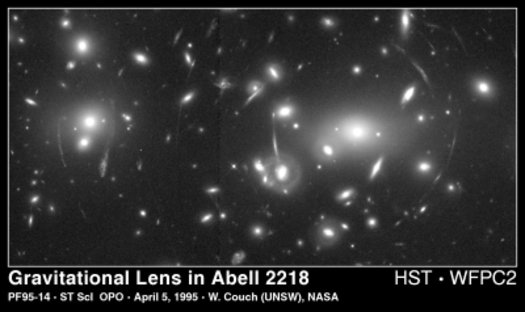
A
Hubble Space Telescope image showing
an example of
gravitational lensing of background
objects by a massive cluster of galaxies
- The gravitational field of a black hole is so strong that
light rays are bent back
to the black hole: they can't escape.
-
With no photons able to leave, all communication with the world outside
the black hole is impossible
-
The matter inside the black hole has
effectively disappeared
from the universe, leaving only its
gravitational field behind to betray
its presence.
THE STRUCTURE OF A BLACK HOLE
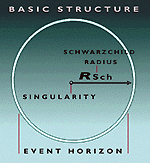

-
The minimum distance you can get from a black hole and still
escape its gravitational field
(if you are traveling the speed of light)
is called the Schwarzschild radius.
-
The surface of an imaginary
sphere with radius equal to the Schwarzschild
radius and centered on the black hole is called the event
horizon.
-
The Schwarzschild radius of any object
depends on its mass.
-
For the Earth, it is about
1 centimeter.
- For Jupiter, it is
3 meters.
- For the Sun, it
is 3 kilometers.
WHAT HAPPENS NEAR A BLACK HOLE?
- Even before reaching the event horizon, an object falling into a black hole
will be pulled apart by tidal forces.
- Near a black hole,
space
and time
are
warped
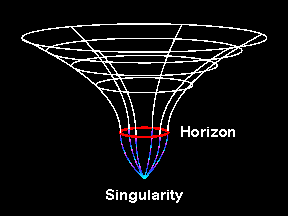
An illustration of spacetime
warping by a black hole
(Image from
Andrew Hamilton.)

Imagine a star near the event horizon of a black hole.
Light going away
from the black hole is
redshifted; light moving
towards
the black hole is
blueshifted.
(Image from
Andrew Hamilton)
- Clocks near black holes run slower than clocks in a weaker gravitational field.
- SPECULATION:
a black hole may lead to other Universes:
wormhole

A diagram of a wormhole
(Image from
Andrew Hamilton.)
HOW DOES ONE FIND A BLACK HOLE?
 (from
Andrew Hamilton.)
(from
Andrew Hamilton.)
- Black holes can be found by:
- 1. Their
gravitational effects on other
objects.
-
2.
X-ray radiation from material falling into the black hole.

- One of the best examples in the Milky Way: Cygnus X-1
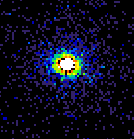
An X-ray image of
Cygnus X-1 from the
EXOSAT satellite
- Cygnus X-1 is a very bright
X-ray source
- There is a blue star near this X-ray source
- Studies of the motion of this
star shows it has an invisible companion,
with a mass at least 10 times that of the Sun:
the black hole
- Gas from the blue star is falling into the black hole.
- Before it gets inside the event horizon, it emits X-rays.
- In the center of the Milky Way galaxy
(in the constellation
of Sagittarius)
there is believed
to be a black hole a million times
more massive than than the Sun.
- In the centers of some other galaxies, there are black holes
that are a billion times
the mass of the Sun.
- Some of these very massive black holes squirt out beams of charged particles,
creating huge plumes of
radio emission that extend beyond the galaxy into intergalactic space.
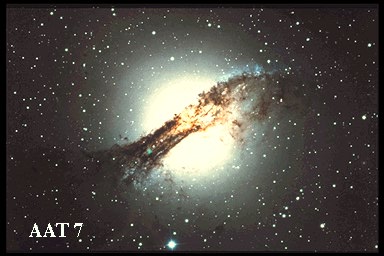

Top: An optical image of the peculiar elliptical galaxy Centaurus A.
The white glow is from stars, the dark band is absorption from interstellar dust.
Bottom: The same image, with the radio jets superposed.
(Optical image copyright
Anglo-Australian Observatory, reproduced with permission.
Radio image from
Jack Burns.











 (from
Andrew Hamilton.)
(from
Andrew Hamilton.)



